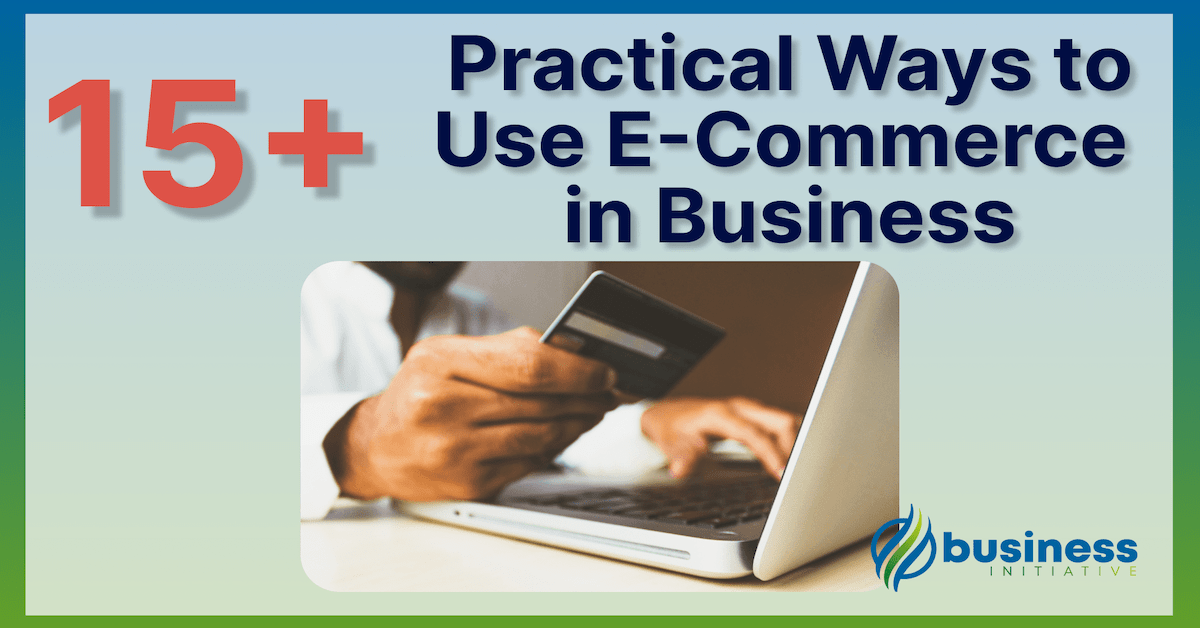In today’s digital age, integrating e-commerce into your business is a must.
With the constant evolution of technology and the shift in consumer behavior towards online shopping, it’s more important than ever to stay ahead of emerging trends.
However, this can be a daunting task for many businesses.
That’s why at the end of the article, we’ve included a list of practical ways you can use e-commerce principles in your business.
 Key Takeaways
Key Takeaways
- Conducting market research is essential before integrating e-commerce into your business.
- A great user experience is critical for success in e-commerce.
- Mobile optimization is crucial as mobile devices make up a significant portion of online traffic.
- Social media can be a powerful tool to drive traffic and sales to your e-commerce platform.
- Utilizing analytics tools can help you track performance and optimize your e-commerce strategy for success.
Whether you’re just starting out or looking to optimize your existing e-commerce strategy, these ideas will help you navigate the challenges and capitalize on the opportunities that come with selling online.
So if you’re ready to take your business to the next level and join the ranks of successful e-commerce businesses, keep reading!
 Table of Contents
Table of Contents
Conduct Market Research
Conducting market research is essential before integrating e-commerce into your business.
According to a report by Oberlo, 42% of businesses fail because they didn’t conduct enough market research.
Market research helps you understand your audience, their needs, and preferences.
Understanding your audience will help you create a successful e-commerce platform that meets their needs.
The most common methods of conducting market research are surveys, focus groups, and customer feedback.
Choose the Right E-commerce Platform
Choosing the right e-commerce platform is crucial for a successful e-commerce integration.
According to a report by Digital Commerce 360, there are more than 2.1 million online stores powered by Shopify alone.
There are many e-commerce platforms available, such as Shopify, WooCommerce, Magento, and BigCommerce.
When choosing an e-commerce platform, consider factors such as cost, customization, ease of use, and scalability.
A report by BuiltWith found that Shopify is the most popular e-commerce platform with a market share of 25%.
Optimize Your Website for E-commerce
To integrate e-commerce into your business, you need to optimize your website for e-commerce.
This includes creating a user-friendly interface, optimizing your website for search engines, and ensuring that your website is secure.
According to a report by Baymard Institute, 69% of online shopping carts are abandoned before the purchase is completed.
A user-friendly interface can help reduce cart abandonment rates.
Furthermore, search engine optimization (SEO) can help increase visibility and traffic to your website.
This article by Moz provides helpful tips on how to optimize your website for SEO.
Integrate Payment Processing
Integrating payment processing is crucial for any e-commerce platform.
Payment processing allows customers to make payments on your website.
When integrating payment processing, consider factors such as security, ease of use, and compatibility with your e-commerce platform.
According to a report by Statista, the global mobile payment revenue is expected to reach 1 trillion U.S. dollars by 2023.
This highlights the importance of integrating mobile payment options into your e-commerce platform.
Develop a Marketing Strategy
Developing a marketing strategy is essential for a successful e-commerce integration.
Your marketing strategy should include tactics such as social media marketing, email marketing, and content marketing.
It should also include tactics for generating traffic to your e-commerce platform.
A report by HubSpot found that 80% of marketers have seen an increase in traffic to their website by investing in content marketing.
Therefore, creating relevant and engaging content can help drive traffic to your e-commerce platform.
Provide Excellent Customer Service
Providing excellent customer service is crucial for any business, and it is especially important for e-commerce platforms.
Your customer service should include features such as live chat, email support, and phone support.
It should also include a clear return policy and shipping information.
According to a report by Zendesk, 82% of customers stopped doing business with a company due to poor customer service.
Therefore, investing in customer service can help retain customers and increase customer loyalty.
In today’s digital age, using e-commerce tools in your company is crucial.
E-commerce allows you to reach a wider audience, increase sales, and enhance customer engagement.
However, integrating e-commerce into your business can be challenging.
Below, we provide some practical ideas on how to integrate e-commerce into your business.
18 Practical Ideas for Integrating E-commerce into Your Business

1. Niche online marketplaces:
Identify a specific product category or target audience and create a dedicated e-commerce platform catering to their unique needs, such as eco-friendly products, locally made crafts, or specialized hobby items.
2. Subscription box services:
Develop a curated subscription box service tailored to specific interests or lifestyles, providing customers with regular deliveries of handpicked items that cater to their preferences.
➤ MORE: Build brand loyalty within your market by automating your payment processing!
3. Virtual consultations and sales:
Offer personalized virtual consultations for products or services through video calls, allowing customers to receive expert advice and make informed purchases from the comfort of their homes.
4. Augmented reality shopping experiences:
Integrate augmented reality (AR) technology into your e-commerce platform, enabling customers to virtually try on products like clothing or visualize furniture in their homes before making a purchase.
5. Social media selling:
Utilize social media platforms with built-in e-commerce features, such as Instagram Shopping or Facebook Marketplace, to sell your products directly to consumers while increasing brand visibility and engagement.
6. E-commerce software solutions:
Create custom e-commerce software solutions for small businesses looking to enhance their online presence – from website design and development to inventory management systems and mobile apps.
7. Dropshipping partnerships:
Establish a dropshipping business model where you partner with suppliers who handle inventory storage and shipping logistics while you focus on marketing and customer service efforts.
8. Online workshops and courses:
Leverage your expertise in a particular field by offering online workshops or courses through your e-commerce platform, allowing customers to access valuable learning resources while diversifying your revenue streams.
9. Expand your existing brick-and-mortar store to the online world:
If you already run a physical store, consider creating an e-commerce website to sell your products or services online.
This will allow you to reach a wider audience and increase sales.
10. Offer online-exclusive products or discounts:
Encourage customers to shop online by providing exclusive deals or unique items that are only available on your e-commerce platform.
11. Utilize social media and digital marketing:
Promote your e-commerce business through targeted advertising on popular social media platforms like Facebook, Instagram, and Twitter.
Utilize search engine optimization (SEO) strategies to improve your website’s visibility on search engines like Google.
12. Implement user-friendly website design:
Ensure that your e-commerce website is easy to navigate and visually appealing, with clear product descriptions and high-quality images.
Optimize it for mobile devices as well, since many consumers prefer shopping on their smartphones.
13. Provide exceptional customer service:
Offer prompt and helpful customer support through various channels such as email, live chat, or phone calls.
This will help build trust with potential customers and encourage repeat purchases.
14. Offer flexible payment options:
Integrate multiple payment methods on your e-commerce site, including credit cards, PayPal, Apple Pay, Google Pay, and other popular options.
15. Streamline order fulfillment:
Develop an efficient system for processing orders and shipping products promptly to ensure customer satisfaction.
16. Leverage email marketing campaigns:
Build an email list of subscribers who are interested in your products or services and send them regular updates about new arrivals, special promotions, or relevant industry news.
17. Monitor analytics data:
Use tools like Google Analytics to track key performance indicators (KPIs) such as traffic sources, bounce rate, conversion rate, average order value (AOV), and customer lifetime value (CLV) to make data-driven decisions for your e-commerce business.
18. Collaborate with influencers and bloggers:
Partner with relevant influencers or bloggers in your niche to promote your products or services through sponsored posts, product reviews, or affiliate marketing programs.
This can help increase brand awareness and drive more traffic to your online store.
By incorporating these practical ideas into your new or existing business strategy, you can tap into the lucrative world of e-commerce while staying ahead of emerging trends and consumer demands in 2023.
Examples of Companies Successfully Integrating E-Commerce
Let’s take a look at some companies that have successfully integrated e-commerce into their business:
Warby Parker:

Warby Parker is an eyewear company that has successfully integrated e-commerce into its business model.
The company offers customers the ability to try on glasses virtually and provides free shipping and returns.
This has helped the company increase its online sales while maintaining a high level of customer satisfaction.
Casper:

Casper is a mattress company that has disrupted the traditional mattress industry by offering customers the ability to purchase mattresses online and have them delivered directly to their door.
The company also offers a 100-night sleep trial, which has helped it gain a loyal customer base.
Dollar Shave Club:

Dollar Shave Club is a subscription-based service that delivers razors and other grooming products to its customers on a monthly basis.
The company’s e-commerce platform allows customers to easily manage their subscriptions and make changes as needed.
Saddleback Leather:

Saddleback Leather is a leather goods company that has built its brand around quality craftsmanship and exceptional customer service.
The company’s e-commerce platform allows customers to easily purchase products online, and its focus on customer satisfaction has helped it build a loyal following.
Stitch Fix:

Stitch Fix is an online personal styling service that uses data science to curate personalized clothing recommendations for its customers.
The company’s e-commerce platform allows customers to easily manage their accounts, provide feedback on items they receive, and make purchases directly from the site.
These companies demonstrate how integrating e-commerce into your business can help you reach new audiences, increase sales, and enhance customer engagement.
FAQs - Frequently Asked Questions About Using E-Commerce in Your Business

Why is market research vital before integrating e-commerce into my business?
Market research helps identify customer needs and preferences, essential for tailoring your e-commerce strategy.
Learn More...
Before launching an e-commerce initiative, understanding your target market's needs, preferences, and buying behaviors is crucial.
Market research informs product offerings, pricing strategies, and marketing approaches, ensuring they align with customer expectations.
- It helps mitigate risks by validating demand before significant investments.
- Enables personalized marketing, enhancing customer engagement and loyalty.
- Facilitates competitive analysis to position your e-commerce effectively in the market.
According to Oberlo, 42% of businesses fail due to insufficient market research, highlighting its critical role in e-commerce success.
What are the key factors to consider when choosing an e-commerce platform?
Consider factors like cost, customization capabilities, ease of use, and scalability.
Learn More...
Choosing the right e-commerce platform is pivotal for integrating digital sales into your business.
Evaluate different platforms based on their cost-effectiveness, ability to customize to your business needs, user-friendliness for both you and your customers, and the capacity to grow with your business.
- Shopify leads with a 25% market share, offering extensive support and integration options.
- Assess platforms like WooCommerce, Magento, and BigCommerce for their unique strengths.
- Check compatibility with your existing operations and potential for integrations with other tools.
Digital Commerce 360 indicates a vast array of platforms, making it crucial to select one that aligns best with your business objectives and budget.
How does a user-friendly website interface impact e-commerce success?
A user-friendly interface can significantly decrease cart abandonment rates and enhance customer satisfaction.
Learn More...
The interface of your e-commerce website plays a critical role in how potential customers perceive and interact with your brand.
Features like easy navigation, quick load times, and efficient checkout processes make shopping convenient, reducing the likelihood of cart abandonment.
- Baymard Institute reports a 69% average cart abandonment rate, which can be mitigated by a smoother user experience.
- Incorporate clear calls to action, concise product information, and responsive design.
- Optimizing for mobile devices is crucial as a significant portion of users shop via smartphones.
Effective website design improves SEO, drives higher traffic, and converts more sales by meeting customer expectations and facilitating easier purchases.
What are some effective marketing strategies for an e-commerce business?
Focus on content marketing, social media engagement, and targeted email campaigns.
Learn More...
Developing a robust marketing strategy is essential to drive traffic and conversions to your e-commerce site.
Utilize content marketing to provide valuable information that attracts and retains a clearly-defined audience, ultimately driving profitable customer action.
- Leverage social media platforms to build brand awareness and directly sell through features like Instagram Shopping.
- Email marketing remains a powerful tool for personalizing offers and maintaining customer relationships.
- Invest in SEO strategies to enhance your site's visibility on search engines.
HubSpot reports that 80% of marketers note an increase in site traffic through strategic content marketing, underscoring its value in an effective e-commerce marketing plan.
Why is integrating payment processing crucial in e-commerce?
Secure and versatile payment options ensure a smooth checkout process, increasing customer trust and conversion rates.
Learn More...
Payment processing is the backbone of e-commerce, handling the transaction part of online shopping.
Offering a variety of payment methods, including credit cards, mobile wallets, and online payment systems like PayPal, caters to customer preferences and enhances convenience.
- Security is paramount; ensure your payment gateway complies with the latest security standards to protect customer data.
- Consider the global reach of payment methods if you plan to sell internationally.
- Statista forecasts global mobile payment revenue to hit 1 trillion USD by 2023, indicating the growing importance of mobile-friendly payment solutions.
Efficient payment processing improves user experience, reduces abandonment at the checkout stage, and can directly boost your overall sales effectiveness.
In Summary
Integrating e-commerce into your business can seem challenging, but it is necessary in today’s digital age.
By following the practical ideas outlined in this article, you can create a successful e-commerce platform that caters to the needs of your audience.
Conducting thorough market research, choosing the right e-commerce platform, optimizing your website for e-commerce, integrating payment processing, developing a marketing strategy, and providing excellent customer service are all crucial steps to take.
By using this information and implementing it into your business strategy, you can gain a wider audience reach, increase sales revenue and enhance customer engagement.
Utilizing social media platforms with built-in e-commerce features like Instagram Shopping or Facebook Marketplace can help sell products directly to consumers while increasing brand visibility and engagement.
Creating custom e-commerce software solutions and offering personalized virtual consultations for products or services through video calls allows customers to make informed purchases from the comfort of their homes.
To learn more about how you can integrate e-commerce into your business successfully, schedule a consultation call with Business Initiative or contact us through our website’s contact form.
You can also subscribe to our newsletter or follow us on X (Twitter) for updates on the latest trends and tips in the industry.


